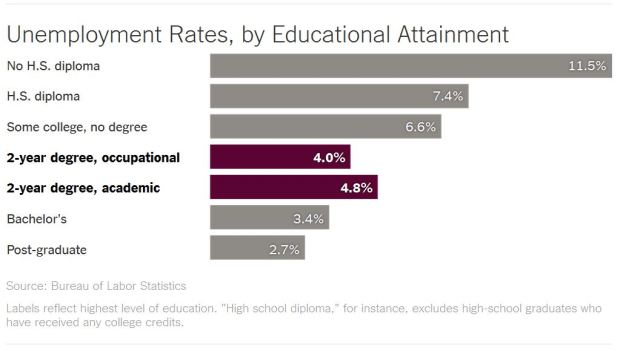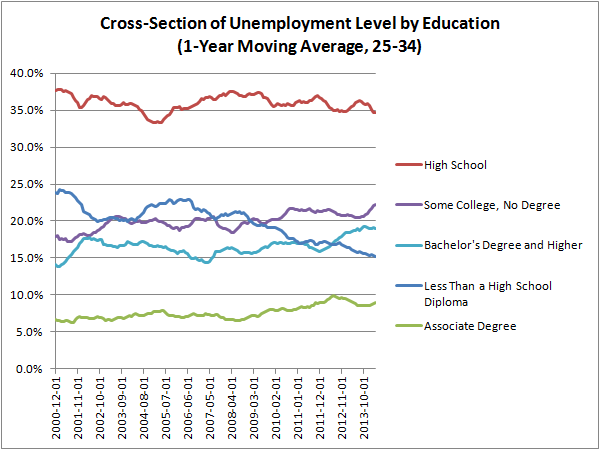…Okay, not the Internet (I hope), just FRED, but it’s an unfortunate performance by David Leonhardt, who was the star of an outing earlier this week.
In “The Jobless Rate for Community-College Graduates Is Also Low,” he teaches us:
The federal government’s main educational-attainment categories are fairly blunt. In particular, the “some college” category includes a wide array of people: Those who have dropped out of college without earning any degree, those who have earned a two-year degree meant to lead directly to a job (such as in nursing) and those who have earned an academic two-year degree that is often a first step toward a bachelor’s degree.
…
[T]he Bureau of Labor Statistics does distinguish among the different versions of “some college.” (It would be even better if the bureau made this data easily available to the public.)
I get the feeling Leonhardt does not use government data much. For one, I’ve never seen “some college” include associate’s degrees in any dataset. For another, the data series Leonhardt refers to are in fact easily available to the public and can be found on FRED (Federal Reserve Economic Data).
Here’s Leonhardt’s chart:
Here’s my version from FRED (just “some college” and “associate degrees” types):
See? Now we can replace him with a robot?
Okay, I’m just being a meanie. Leonhardt’s ignorance is an honest mistake and I’m sure if he spent a couple weekends learning how to use FRED he wouldn’t be wasting his readers’ time telling them information is unavailable when it is. However, his ignorance is a thin end of a wedge. It may seem trivial, but FRED represents one of the great advances of this decade: easy access to government information. Instead of trying to find Brazil’s GDP in an encyclopedia, one can look on Fred or the IMF’s or World Bank’s Web site. FRED doesn’t have all datasets yet, but journalists should be turning to it first when researching government data. I’m sure they will be within a decade, but ones like Leonhardt really need to familiarize themselves with it.
But since we’re on the topic of the unemployment of the educated, I thought I’d take another crack at it. Leonhardt compares unemployment rates by education to conclude that, as the title of his article suggests, two-year colleges are a good bet too—so long as students get the degrees.
Comparing these unemployment rates doesn’t sit well with me because they all use different denominators. The high unemployment rate for those who have less than a high school diploma might be less significant if there aren’t that many non-high-schoolers in the labor force. Likewise, a low unemployment rate for college graduates might be problematic if there’s a large number of them. So, using FRED, I gathered the unemployment level (not the rate) by education for the 25 to 34 age bracket (yes, FRED now has that), and I decided to do a cross-sectional analysis of the unemployed by their educational attainment.
The data only go back to 2000, but here you are:
The results are slight but the trends are clear: The educational attainment of the young unemployed is rising. As of last April, for the first time, half of them had at least some college education. In May 2007, about 22 percent of the young unemployed had an associate’s degree or bachelor’s degree; now it’s 28 percent. Meanwhile the percent of the unemployed who haven’t finished high school, whose 11.5 percent unemployment rate typically alarms Leonhardt and his peers, has fallen from 24 percent to 15 percent of the total.
You might be tempted to say that the unemployment level doesn’t include people who drop out of the labor force. True, but (a) that’s not Leonhardt’s argument, and (b) the labor-force dropouts might be more educated too. Go ahead, prove me wrong.
The point is, if Leonhardt et al. are right about how crucial education is, then we would expect the proportion of educated unemployed to be declining. On the contrary, we see that as we educate more people, it just substitutes the uneducated unemployed with the educated. It calls into question the mantra that “college graduates are less likely to be unemployed.”
**********
UPDATE: Allow me to clarify my thoughts here. Nothing I’ve written here should be interpreted as saying that, for example, people shouldn’t finish high school because they’re a smaller proportion of the unemployed. The unemployment rate by education does matter for the obvious reasons we read about, like employers not wanting to hire uneducated people. However, my point is to draw attention to the evidence that if the more education people attain, the better-educated the unemployed become. Irrespective of the unemployment rate by education, this phenomenon supports the signaling theory because we’d expect the unemployed to be less educated over time.



2 comments